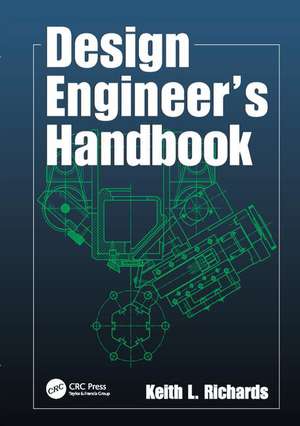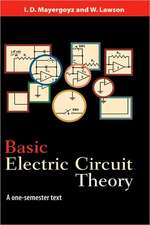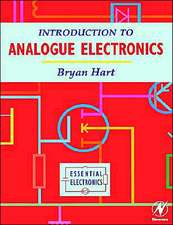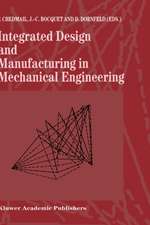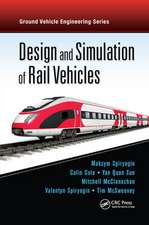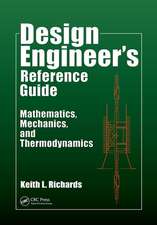Design Engineer's Handbook
Autor Keith L. Richardsen Limba Engleză Paperback – 29 mar 2017
This book conveys the author’s insights from his decades of experience in fields ranging from machine tools to aerospace. Sharing the vast knowledge and experience that has served him well in his own career, this book is specifically aimed at the student design engineer who has left full- or part-time academic studies and requires a handy reference handbook to use in practice. Full of material often left out of many academic references, this book includes important in-depth coverage of key topics, such as:
- Effects of fatigue and fracture in catastrophic failures
- Lugs and shear pins
- Helical compression springs
- Thick-walled or compound cylinders
- Cam and follower design
- Beams and torsion
- Limits and fits and gear systems
- Use of Mohr’s circle in both analytical and experimental stress analysis
| Toate formatele și edițiile | Preț | Express |
|---|---|---|
| Paperback (1) | 469.23 lei 6-8 săpt. | |
| CRC Press – 29 mar 2017 | 469.23 lei 6-8 săpt. | |
| Hardback (1) | 1123.68 lei 6-8 săpt. | |
| CRC Press – 2 oct 2012 | 1123.68 lei 6-8 săpt. |
Preț: 469.23 lei
Preț vechi: 552.04 lei
-15% Nou
Puncte Express: 704
Preț estimativ în valută:
89.80€ • 97.51$ • 75.43£
89.80€ • 97.51$ • 75.43£
Carte tipărită la comandă
Livrare economică 23 aprilie-07 mai
Preluare comenzi: 021 569.72.76
Specificații
ISBN-13: 9781138076945
ISBN-10: 1138076945
Pagini: 384
Ilustrații: Approx. 312 equations; 77 Tables, black and white; 260 Illustrations, black and white
Dimensiuni: 178 x 254 x 20 mm
Greutate: 0.68 kg
Ediția:1
Editura: CRC Press
Colecția CRC Press
ISBN-10: 1138076945
Pagini: 384
Ilustrații: Approx. 312 equations; 77 Tables, black and white; 260 Illustrations, black and white
Dimensiuni: 178 x 254 x 20 mm
Greutate: 0.68 kg
Ediția:1
Editura: CRC Press
Colecția CRC Press
Cuprins
Beams. Torsion of Solid Sections. Design and Analysis of Lugs and Shear Pins. Mechanical Fasteners. Limits and Fits. Thick Cylinders. Compound Cylinders. The Design and Analysis of Helical Compression Springs Manufactured from Round Wire. Introduction to Analytical Stress Analysis and the Use of the Mohr Circle. Introduction to Experimental Stress Analysis. Introduction to Fatigue and Fracture. Introduction to Geared Systems. Introduction to Cams and Followers.
Notă biografică
Keith L. Richards brings more than 55 years of practical experience as a design engineer to his Design Engineer’s Handbook. After completing an apprenticeship program and earning a Masters degree in Engineering Design from Loughborough University, UK, he worked in a wide range of industries, including work on steel and aluminum rolling mills, power transmission systems, aircraft components, power plants, offshore structures, and pneumatic/hydraulic circuits. He is proficient in CAD and computational software, and in applied stress analysis. Additionally, he has worked in project management, purchasing, contracts, and creation of design plans. He has tapped his broad range of engineering activities to make Design Engineer’s Handbook an indispensable guide for both new and experienced engineers.
Descriere
This handbook covers basic subjects that mechanical engineers will meet in their careers as well as the analysis of important machine elements, including shafts, lugs, and shear pins together with mechanical fasteners such as bolts. Emphasizing the use of hand calculations rather than dedicated software enables engineers and engineering students to understand the reasoning behind a particular approach, so that a solution can be readily obtained in the absence of a computer. The chapters cover the general problems that engineers encounter during their work—similar to the problems the writer had to solve in his early career—and provide detailed solutions to such problems.
